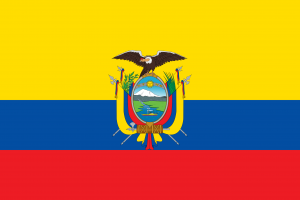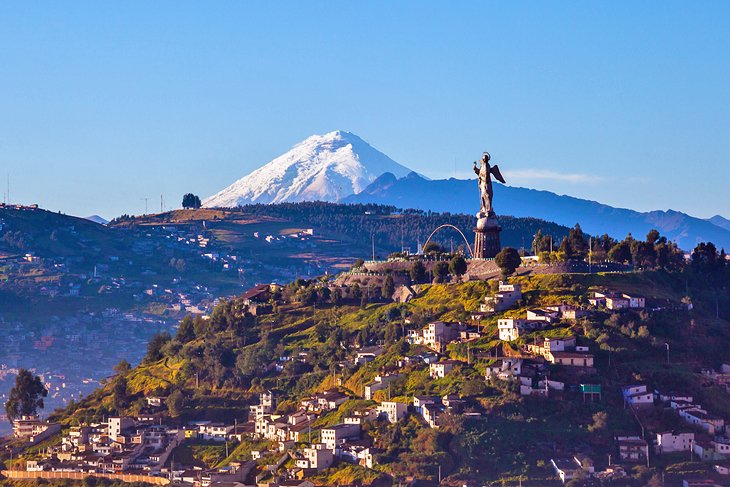Language/Spanish/Culture/Ecuador-Timeline
Jump to navigation
Jump to search
Rate this lesson:
Historical Timeline for Ecuador - A chronology of key events
Ecuador Timeline[edit | edit source]
| Date | Event |
|---|---|
| 10,000 to 3,500 BC AD | human occupation on the coast and in the Sierra. Stone tools. Preceramic period. |
| 5800 BC AD | corn is already known in Ecuador. |
| 3000 BC AD | Real Alto, near Valdivia, is a metropolis where 1,500 to 3,000 people live. |
| 500 to 200 BC. AD | formative period. Cultures of Valdivia, Machalilla, Chorrera ... |
| 200 BC AD to 700-800 | period of regional development, on the basis of organized ethnic groups, on the coast and in the Sierra. Metalworking (gold, copper, lead, silver and platinum). |
| 700 to 1500 | period of cultural integration: regrouping and beginning of embryonic states. From the 8th century, appearance of the Caras, who will found the kingdom of Quito. |
| 1300 to 1400 | the kingdom of Quito stretches from southern Colombia to northern Peru. |
| 1455-1460 | start of the conquest by the Incas of the kingdom of Quito. |
| 1487-1488 | end of the Inca conquest. |
| October 12, 1492 | Christopher Columbus arrives in America. |
| September 21, 1526 | the Spanish pilot Bartolomé Ruíz lands on the Ecuadorian coast. |
| 1527 | death of the Inca Huayna Cápac. |
| 1530-1532 | war between the two Inca emperors Huascar and Atahualpa, the first being finally defeated, then assassinated. |
| 1531 | Francisco Pizarro arrives in Tumbéz, in the north of present-day Peru. |
| September 24-November 15, 1532 | Pizarro goes to Cajamarca. November 16: meeting with Atahualpa who is taken prisoner. |
| August 29, 1533 | execution of Atahualpa. |
| December 6, 1534 | founding of Quito by Sebastián de Benalcázar. |
| 1534 | foundation of the first bishopric of Quito. |
| 1537-1538 | foundation (definitive) of Guayaquil. |
| May 1541 | departure for the Orient of an expedition led by Gonzalo Pizarro, helped by Francisco de Orellana. |
| August 1542 | Orellana, after discovering the Amazon, arrives at the Atlantic. |
| 1544 | Spanish revolt against Madrid, led by Gonzalo Pizarro. The viceroy of Peru was killed in 1546. |
| 1548 | end of the rebellion; arrest and execution of Pizarro. |
| August 29, 1563 | creation of the Royal Audience of Quito. |
| 1569 | installation in Lima of a tribunal of the Inquisition, with jurisdiction over Ecuador. |
| 1575 | foundation of Riobamba. |
| 1586 | arrival of the Jesuits in Quito. |
| 1592 | uprising known as the Alcabalas, in Quito. |
| 1606 | founding of Ibarra. |
| 1736 | arrival of La Condamine and the French geodetic mission. |
| 1765 | uprising of the suburbs of Quito (revolution of estancos or drinking establishments). |
| 1767 | expulsion of the Jesuits from all the Spanish colonies. |
| November 1780 | Indian uprising led by Túpac Amaru II, near Cuzco. |
| May 18, 1781 | execution of Túpac Amaru II. The Indian struggle continued for several months. |
| 1783 | birth of Simón Bolívar in Caracas. |
| August 1809 | first sovereign government junta in Quito. |
| 1811 | Congress of Free Peoples of the Audience of Quito. Proclamation of the independence of Quito. |
| February 5, 1812 | first constitution, never applied. |
| proclaims its independence. | |
| 1822 | success of the patriotic armed forces in , then victory of the Pichincha (May 24) over the Spaniards. Entry of Bolívar into Quito. Interview, July Guayaquil, Bolívar and San Martín. |
| 1828 | war between Peru and Colombia. Victory of Colombia in 1829. |
| breaks with Grande-Colombia and declares itself free and independent. General Juan José Flores is appointed president. | |
| December 17, 1830 | death of Simón Bolívar. |
| 1832 | Ecuador takes possession of the Galapagos Islands. |
| 1860 | Gabriel García Moreno enters the scene. |
| 1861 | abolition of slavery in Ecuador. |
| August 12, 1875 | assassination of García Moreno. |
| 1893 | the Salesians take charge of the evangelization of the Shuar (Jivaros). |
| 1895 | triumph of the liberal revolution of Eloy Alfaro, who becomes president. |
| 1897 | construction of the Guayaquil-Quito railway begins. |
| January 1912 | assassination of Eloy Alfaro. |
| November 15, 1922 | bloody repression of the general strike in Guayaquil, a thousand dead. |
| July 9, 1925 | July revolution led by a group of young officers. |
| December 1933 | first presidency of José María Velasco Ibarra. |
| July 5-30, 1941 | armed aggression by Peru against Ecuador. |
| January 1942 | protocol of Rio de Janeiro, which removes from Ecuador, in favor of Peru, nearly half of its territory. |
| July 11, 1963 | the military take power. First agrarian reform the following year. |
| 1968 | Velasco Ibarra elected, for the fifth time, President of the Republic. |
| May 26, 1969 | creation of the Andean Pact, an economic integration body to which Ecuador adheres. |
| June 15, 1972 | General Guillermo Rodríguez Lara forms a nationalist and revolutionary government. |
| April 25, 1979 | return to democracy with civilian president Jaime Roldós. |
| May 22, 1981 | death in a plane crash of President Roldós, his wife and several ministers. |
| June 1990 | national uprisingIndian. |
| May 1992 | 11,000 km² recognized as properties of three Amazonian Indian groups. |
| August 10, 1992 | new president Sixto Durán Ballen takes power. |
| July 7, 1996 | election of the new President of the Republic, Abdalá Bucaram Ortíz (Ecuadorian Roldosist Party). |
| October 30, 1996 | signature in Santiago de Chile of a new peace agreement between Peru and Ecuador, supposed to put an end to the border conflict between these two countries since 1942. |
| February 1997 | dismissal of President Abdalá Bucaram, known as El Loco. Interim presidency of Fabián Alarcón. |
| 1998 | election of Jamil Mahuad as President of the Republic in a context of falling oil prices and a serious financial crisis. |
| 2000 | dollarization of the Ecuadorian economy and currency by President Jamil Mahuad, immediately overthrown by a military junta (led by Colonel Lucio Gutierrez) supporting the people's revolt. General Mesa, at the head of another junta, then ousted Gutierrez. President Gustavo Noboa from the same party as Mahuad takes over Ecuador. |
| 2002 | Lucio Gutiérrez is elected President of the Republic, thanks to the support of the indigenous party MUPP-NP. |
| 2005 | President Gutiérrez, losing credibility, dissolves the Supreme Court of Justice by reconstituting it to allow the return of former presidents convicted of corruption: Bucaram, Noboa and Dahik. Despite the support of the United States, Gutiérrez was overthrown by the Ecuadorian people gathered en masse in Quito. On April 21, Alfredo Palacio was appointed interim president of the Republic of Ecuador, until the end of Lucio Gutiérrez's mandate. New presidential elections are scheduled for 2006. |
| 2006 | Rafael Correa was elected president on November 26 on a program advocating a citizens' revolution through radical reforms in particular in favor of the poorest, the renegotiation of the country's debt, the overhaul of oil agreements, the non-renewal of the Manta-based deal with the United States, and the end of power in the hands of corrupt political elites. |
| 2007 | Rafael Correa was invested president on January Zumbahua, a village in the Andes, in front of 20,000 Indians and in the presence of Venezuelan Hugo Chávez and Bolivian Evo Morales. In March, demonstrations in the country, while 57 parliamentarians rejecting the idea of a Constituent Assembly oppose Rafael Correa and the Supreme Court. The same year, the president proposes to the international community to finance the non-exploitation of the oil located in the park of Yasuni, under the Amazonian forest. Richest reservoir of biodiversity in the country. |
| September 29, 2008 | adoption by referendum, with nearly 70% of yes, of the new Constitution laying the foundations of "21st century socialism". |
| April 26, 2009 | presidential elections, Rafael Correa is re-elected President of the Republic of Ecuador with nearly 52% of the vote. |
| September 30, 2010 | a political crisis leads to a police mutiny. President Rafael Correa is in danger, but the military is correcting the situation. |
| May 7, 2011 | as part of a reform policy, the government organized a constitutional referendum, a popular consultation so that the population can give its opinion on 10 questions relating to the following areas: judicial system, security, environment, banking system and means of communication (among others). |
| June 2012 | Rafael Correa grants political asylum to Julian Assange, the Australian founder of Wikileaks, charged with rape and espionage. Refugee in the Ecuadorian embassy in London, he could not reach Latin America at the risk of being arrested by the British authorities. The Ecuadorian president's gesture has been deemed "anti-imperialist" by many countries. |
| February 17, 2013 | Socialist Rafael Correa is re-elected with 56.7% of the vote, against 23.3% of the vote for his main rival Guillermo Lasso, a former banker and member of Opus Dei. The president renounces the Yasuni project in the Amazon. |
| November 2014 | the Constitutional Court makes possible the change of the constitution allowing the renewal of all the mandates to infinity, including that of the Head of State. This would allow the president, Rafael Correa to be a new candidate in 2017. |
| 2015 | in view of the 21st UN conference on the climate issue scheduled for Paris in December 2015, the issue of oil and the Yasuni park are back to the forefront of the news. |
| July 2015 | visit of Pope Francis to South America and therefore to Ecuador (in Gayaquil then Quito). |
| July 2015 | protests across the country against President Correa. The crowd wants to see the president leave, the latter denouncing a conspiracy of the right-wing opposition. |
| April 2016 | an earthquake with a magnitude of 7.8 was felt on April 16, the town of Muisne. The toll is heavy: 668 dead, 8 missing, 6,274 injured and 29,067 homeless. |
| July 10, 2016 | Following the April earthquake, two new tremors with a magnitude of 6.2 and 5.9 hit the region, further weakening the buildings. |
| April 2017 | Lenín Moreno, 64, candidate of the left-wing Alianza País party, wins by a short header in the second round of the Ecuadorian presidential election. he succeeds President Correa, whose action was increasingly criticized. |
Source[edit | edit source]
World Timelines[edit source]
Other Lessons[edit | edit source]
- Ceuta and Melilla Timeline
- Colombia Timeline
- Peru Timeline
- Dominican Republic Timeline
- Timeline of Spain
- Argentina Timeline
- Bolivia Timeline
- Costa Rica Timeline
- Why Learn Spanish
- Life in Spain
- Start Reading in Spanish
- Countries with Spanish as an official language
- Equatorial Guinea Timeline
- Literatura
- Mexico Timeline


